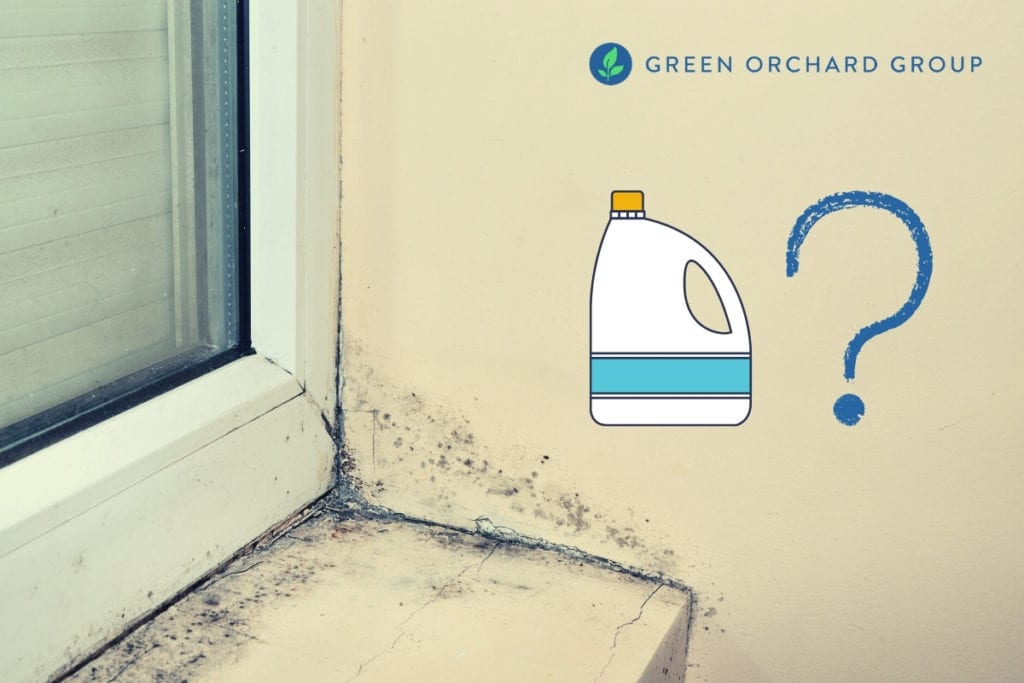
Article Sections:
If you’ve discovered mold growing in your home, especially after a flood or water damage, bleach might be one of the first solutions that come to mind.
However, official guidelines from the CDC, the EPA, OSHA, and other organizations seem to provide different recommendations around the use of bleach to remediate mold, while some internet sources even dismiss it as a myth.
So does bleach actually kill mold?
The answer depends — under certain conditions bleach can effectively kill mold, but it’s often not the optimal approach.
Does Bleach Kill Mold?
The short answer is yes, bleach can kill mold.
Bleach is a biocide, which the EPA defines as a substance that can destroy living organisms — including mold. Applying a diluted bleach solution directly onto a moldy surface will quickly kill any mold that it comes into contact with.
The active ingredient in bleach is sodium hypochlorite (NaOCl), which reacts with water to form hypochlorous acid (HOCl). Hypochlorous acid kills mold, bacteria, and other pathogens by denaturing proteins, inactivating enzymes, disrupting nucleic acids, and destroying important cellular components.
However, where official recommendations seem to differ is whether or not bleach is safe and/or necessary to remediate mold.

When Is It Recommended to Use Bleach?
According to the CDC, bleach may be used to kill mold on hard, nonporous surfaces, such as:
- Tile
- Sinks
- Bathtubs
- Hard plastics
- Painted metal
- Glass
There are certain instances where the use of bleach is recommended for mold cleanup, such as when immuno-compromised individuals are present (according to the EPA).
After using bleach, the dead mold must be removed. It’s not enough to simply kill the mold. Be sure to scrub the surface thoroughly with soap and water, then let it dry completely.
For safety reasons, bleach solutions should be diluted to a ratio of no more than 1 cup of bleach per 1 gallon of water. Wear rubber gloves and goggles when handling bleach, and open doors and windows and allow air to circulate.
As an important note, always follow instructions on product labels and never mix bleach with ammonia or other household cleaners.

When Is It NOT Recommended to Use Bleach?
In most cases, it isn’t necessary to kill mold in order to clean and remove it. Therefore, the EPA does not recommend using bleach as a routine practice during mold cleanup.
Oftentimes, scrubbing the area with water and a detergent is sufficient to dislodge and remove mold from nonporous and semi-porous surfaces. As long as the original cause of the mold growth — for instance, excess moisture or flooding — is properly addressed, the mold will not regrow.
Bleach should not be used to clean mold from porous materials, such as:
- Drywall
- Ceiling tiles
- Carpets
- Fabrics
- Wood
- Granite
Porous materials like drywall are not completely smooth and have small holes and crevices that allow mold to take root underneath the surface. Using bleach may kill mold on outer surfaces, but it doesn’t penetrate into porous materials to kill the mold growing inside.
Unfortunately, there is no good answer for removing mold from porous materials such as ceiling tiles and carpets. Once mold starts to grow inside, it may be difficult or impossible to remove completely. Therefore, they may need to be thrown away and replaced.

When Should You Call a Mold Expert?
Mold cleanup can be complicated and potentially hazardous to your health if safe work practices are not followed.
If the size of the affected area is small (less than 10 square feet), you may be able to handle it yourself safely. For more severe mold problems where there has been a lot of water damage or mold growth covers more than 10 square feet, the EPA recommends hiring a professional.
In New York City, Local Law 55 requires owners of buildings with more than 10 apartments to hire two types of contractors in order to remediate more than 10 square feet of mold:
- The first is a New York State Licensed Mold Assessor who scopes out the problem, determines the underlying cause, and provides recommendations for cleanup.
- The second is a New York State Licensed Mold Remediator who plans and performs the necessary remediation work to get rid of the mold.
Green Orchard Group has more than 25 years of experience as licensed mold professionals in the Tri-State area. Call (212) 219-8261 or contact us to let us know how we can help with your mold problem!
